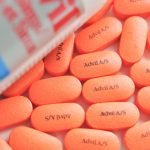Chronic Pain & Gut-Joint Axis
Aoife Earls, MSc, ND
Chronic Pain: a significant health issue
Chronic pain is a significant health issue, and it is estimated that one-half of those suffering with chronic pain have been suffering for longer than 10 years.1 An estimated 52.5 million Americans have been diagnosed with various arthritic disorders,2 conditions that are typically treated with non-steroidal anti-inflammatory drugs (NSAIDs). These drugs work by inhibiting proinflammatory cytokines like interleukin (IL)-6 and tumor necrosis factor-alpha (TNFα), and blocking prostaglandin synthesis.3 It is widely known that prolonged NSAID usage includes side-effects such as ulcers and gastrointestinal (GI) bleeding, bloating, gas, and heartburn.4 NSAIDs are also known to contribute to hyperpermeability of the GI tract, or leaky gut syndrome.5
As alternative health professionals, we are often asked to support various chronic pain conditions – from osteoarthritis (OA) to autoimmune diseases such as rheumatoid arthritis (RA) and spondyloarthritis – without the access to pharmaceutical medications for pain control. We are also often asked to repair the body from these same pharmaceutical interventions. Given the prevalence of joint inflammation in IBD,6,7 and the general prevalence of chronic pain and GI imbalances in aging, it is imperative that our understanding of the gut-joint axis becomes a crucial part of our management of disease, as opposed to pain elimination alone.5,6
Microbiome Status in Chronic Joint Pain
The GI tract is widely understood to be our first line of defense against foreign invaders, through a combination of beneficial commensal bacteria and strong epithelial integrity.8 The proper ratio of “good” flora creates balanced immunity; the presence of higher amounts of lactic-acid bacteria, such as lactobacilli and bifidobacteria, positively influence T-helper regulatory cells, in IBS, pain syndromes, and reactive arthritis.9-11 In contrast, GI tracts with higher colonies of possible pathogens, such as clostridia or Klebsiella, may contribute to joint disease.12-14 Outside of the GI tract, cross-reactivity reactions can form between host tissue bacterial antigens, leading to the production of autoantibodies and triggering inflammatory cascades within the synovium.12
Consumption of probiotics containing lactic-acid bacteria has been associated with reduction of reactive arthritis in animal models of arthritis,12,15,16 and both probiotics and prebiotics have been shown to impact musculoskeletal disorders in human patients.12
However, not all “good” bacteria guarantee healthy joints. Bacterial overgrowth of the small intestine can promote the development of joint pain and systemic fibromyalgia-like syndromes. In animal models of RA, rats who were kept in sterile conditions did not develop the disease until they were exposed to normal bacterial colonies and their colons were able to grow “normal” bacterial flora.15,17 Only after this did they develop synovitis, or joint inflammation. Germ-free rats have also been shown to have reduced gut and joint inflammation.18 Therefore, the key is keeping bacterial flora in the right ratios, properly balanced between cellular-mediated immunity (Th1) and humoral immunity (Th2).19 Two key strategies address this line of thought: proper nutrition and stress hormone regulation.
Nutritional Support for Arthritis
No specific foods have been clearly elucidated as deleterious for chronic pain; however, there is currently much more discussion about which foods should be avoided than included, with respect to chronic pain management. Sugar, for example, has been linked with increased risk for the development of RA.20 It is also known that simple carbohydrates influence gut microbiota: in both humans and animal models, a western diet (high fat/high sugar) has been shown to enhance counts of Firmicutes species and to decrease counts of Bacterioidetes species.21,22
In contrast, current research suggests that consuming vegetarian-type diets that are rich in fiber, antioxidants, and/or Lactobacillus, might reduce pain, thereby improving quality of life in RA patients.23,24 With respect to OA, similar results can be seen with consumption of avocado and soy vegetable extracts, again supporting the notion that vegetarian-type diets are beneficial for pain reduction, increased mobility, and prevention and inhibition of joint cartilage degradation.25 It is clear that emphasizing vegetable-based diets reduces pain across multiple joint pathologies; however, further research is needed to determine mechanisms and specific dietary ratios that are optimal for pain reduction.
Food Sensitivities & Joint Inflammation
It is also possible that undiagnosed food allergies and/or intolerances can be inflammatory triggers for chronic pain in the musculoskeletal system. Because food intolerances and allergies can be challenging to diagnose, and testing for these disorders is variable in terms of sensitivity and specificity (especially for intolerances of the IgG classes),26 elimination diets are still the current gold standard for diagnosis. Clinically speaking, many of my patients report feeling better with reduced dairy or wheat gluten consumption, and the most commonly explored triggers include cow’s milk antigens (α‐lactalbumin, β‐lactoglobulin, casein), wheat and wheat gluten, eggs (ovalbumin), and soy proteins. A case study in 1981 revealed dairy elimination to reduce pain, stiffness, and grip strength in a patient with RA,27 and a randomized controlled trial of 94 RA patients showed that elimination of milk protein in a subset of patients with dairy allergy improved their disease activity.28
A recent study of 14 RA patients and 20 healthy controls revealed overall increased production of IgA, IgG, and IgM antibodies in the jejunum of many of the RA patients compared to controls, which may be related more to overall increased immune activity and cross-reactivity reactions.29 So, the foods themselves may be less of an issue than the general hyperactivity of the immune system in rheumatoid disease. With hidden allergens in processed foods, including dairy and gluten, it does encourage a whole-foods diet for decreased reactivity of the immune system in any arthropathy.
And perhaps our methods of assessment should be reconsidered. Serum antibodies to certain foods may not adequately reveal food intolerances or allergies, and perhaps it is in the intestinal mucosa where change is truly best assessed, as it often is in celiac disease. A group exploring food intolerances in patients with Sjogren’s syndrome noted increased rectal mucosal activity (via mucosal patch test) in response to cow’s milk protein in 8 of the 21 patients, which was not attributed to IgA or IgG antibodies.30 Many of these patients also had IBS symptoms, and a few were also sensitive to gluten. To date, no studies have explored the same line of thought for RA, OA, reactive arthritis, or chronic pain syndromes. Encouraging wholesome eating (whether cooked or raw as tolerated), is therefore an essential part of treatment management, while also investigating possible immune reactivity to food in patients with inflammation and pain.
Influence of Stress Hormones on the Gut-Joint Axis
Chronic pain itself is a physically and emotionally taxing condition. Managing stress hormones should be a significant component of treatment, especially considering the fact that chronic pain decreases quality of life, not only through changed activity levels and physical restrictions, but also by the depression and anxiety that can often develop in tandem.31
We know from research that corticotropin-releasing hormone (CRH) can compromise intestinal lumen integrity.32 Consequently, it stands to reason that gut health and chronic pain and joint inflammation are intimately connected. The added challenge is that with stress, serotonin can decrease while cortisol increases, both of which may promote carbohydrate cravings to improve mood and serve as a coping mechanism.33 Overweight OA patients have been found to have higher levels of pain compared to normal-weight individuals, and also to experience symptom relief from eating high-fat/high-sugar foods.34 Weight gain can be deleterious to chronic pain conditions due to the extra pressure put on inflamed joints, and we know that this kind of diet can also contribute to imbalanced gut flora, as previously discussed. Both hypocortisol and hypercortisol states can be linked with chronic pain.31 Hypocortisol has associations with kidney yang deficiency (cold, aching body, exhaustion, diarrhea, IBS-like conditions), which has been shown in an animal model to be treated effectively with herbal medicine.35
What is fascinating is that Curcuma longa (curcumin), well-known for its ability to ameliorate chronic pain in most arthropathies,36-38 may also decrease cortisol. In animal models of chronic constrictive pain, as often seen in neuropathic pain disorders in humans, hypersensitivity to pain (hyperalgesia) and cortisol levels were reduced with curcumin consumption.39 Downregulation of IL-6, TNFα, and IL1β, key mediators in inflammatory pain and immune chronic upregulation, are seen with curcumin interventions in similar animal models.40 Curcumin usage clearly gets to the root cause of inflammation, not only by influencing immunity, but also by decreasing stress hormones. In an animal model, curcumin was also able to significantly influence western diet-induced intestinal permeability and systemic inflammation.41
We see a similar relationship between the gut-joint axis and Boswellia serrata in OA patients.42 Findings are promising and support further exploration. Rehmannia glutinosa, also utilized for many centuries in Chinese medicine as a cortisol regulator, adaptogen, and a mediator in autoimmunity, has been shown in rat models to reduce chronic neuropathic pain in a dose-dependent manner.43
Conclusion
That many individuals are seeing out nutritional or herbal treatments to support or reduce dependence on pharmaceutical pain intervention for chronic pain is encouraging. We are forced, again, to look at the root causes of pain expression, rather than to merely palliate, despite our ability to do so and our personal desire to alleviate suffering. By continuing to focus on the gut-joint axis, we are led to more successful management of chronic pain.
 Aoife Earls, MSc, ND, is a naturopathic doctor from Toronto, Ontario. She holds a Bachelor of Science and a Masters of Science from McMaster University in Hamilton, ON. Her interest in chronic disease developed in her masters through her exploration of animal models of lupus-like disease and changes in the endocrine system. She went on to study naturopathic medicine at the Canadian College of Naturopathic Medicine in Toronto, ON, and graduated in 2008. She writes for various integrative health publications and lectures extensively on alternative health, with a focus on integration of the body and mind in health. Currently, Dr Earls practices in Oakville, ON, and lives in Toronto with her husband.
Aoife Earls, MSc, ND, is a naturopathic doctor from Toronto, Ontario. She holds a Bachelor of Science and a Masters of Science from McMaster University in Hamilton, ON. Her interest in chronic disease developed in her masters through her exploration of animal models of lupus-like disease and changes in the endocrine system. She went on to study naturopathic medicine at the Canadian College of Naturopathic Medicine in Toronto, ON, and graduated in 2008. She writes for various integrative health publications and lectures extensively on alternative health, with a focus on integration of the body and mind in health. Currently, Dr Earls practices in Oakville, ON, and lives in Toronto with her husband.
References:
- Institute of Medicine (US) Committee on Advancing Pain Research, Care, and Education. Relieving Pain in America A Blueprint for Transforming Prevention, Care, Education, and Research. Washington, DC: The National Academies Press; 2011.
- Centers for Disease Control and Prevention. Arthritis-Related Statistics. Updated March 17, 2015. CDC Web site. http://www.cdc.gov/arthritis/data_statistics/arthritis_related_stats.htm. Accessed March 15, 2015.
- Gallelli L, Galasso O, Falcone D, et al. The effects of nonsteroidal anti-inflammatory drugs on clinical outcomes, synovial fluid cytokine concentration and signal transduction pathways in knee osteoarthritis. A randomized open label trial. Osteoarthritis Cartilage. 2013;21(9):1400-1408.
- Scarpignato C, Hunt RH. Nonsteroidal antiinflammatory drug-related injury to the gastrointestinal tract: Clinical picture, pathogenesis, and prevention. Gastroenterol Clin North Am. 2010;39(3):433-464.
- Tachecí I, Kopácová M, Rejchrt S, Bures J. Non-steroidal anti-inflammatory drug induced injury to the small intestine. Acta Medica (Hradec Kralove). 2010;53(1):3-11.
- Sheth T, Pitchumoni CS, Das KM. Musculoskeletal manifestations in inflammatory bowel disease: a revisit in search of immunopathophysiological mechanisms. J Clin Gastroenterol. 2014;48(4):308-317.
- Brakenhoff LK, van der Heijde DM, Hommes DW, et al. The joint-gut axis in inflammatory bowel diseases. J Crohn’s Colitis. 2010;4(3): 257-268.
- Keita AV, Soderholm JD. The intestinal barrier and its regulation by neuroimmune factors. Neurogastroenterol Motil. 2010;22(7):718-733.
- Theodorou V, Belgnaoui A, Agostini S, Eutamene H. Effect of commensals and probiotics on visceral sensitivity and pain in irritable bowel syndrome. Gut Microbes. 2014;5(3):430-436.
- Gul’neva MIu, Noskov SM. Colonic microbial biocenosis in rheumatoid arthritis. [Article in Russian] Klin Med (Mosk) 2011;89(4):45-48.
- Reichenberger ER, Alexander GM, Perreault MJ, et al. Establishing a relationship between bacteria in the human gut and complex regional pain syndromes. Brain Behav Immun. 2013;29:62-69.
- Vitetta L, Coulson S, Linnane AW, Butt H. The gastrointestinal microbiome and musculoskeletal diseases: a beneficial role for probiotics and prebiotics. Pathogens. 2013;2(4):606-626.
- Rashid T, Wilson C, Ebringer A. The link between ankylosing spondylitis, Crohn’s disease, Klebsiella, and starch consumption. Clin Dev Immunol. 2013;2013:872632.
- Kohn D. Joint Pain, From the Gut. January 12, 2015. The Atlantic. Available at: http://www.theatlantic.com/health/archive/2015/01/joint-pain-from-the-gut/383772/. Accessed May 2, 2015.
- Noto Llana M, Sarnacki SH, Aya Castañeda Mdel R, et al. Consumption of Lactobacillus casei fermented milk prevents Salmonella reactive arthritis by modulating IL-23/IL-17 expression. PLoS ONE. 2013;8(12):e82588.
- Baharav E, Mor F, Halpern M, Weinberger A. Lactobacillus GG bacteria ameloriate arthritis in Lewis rats. J Nutr. 2004;134(8):1964-1969.
- Toivanen P. Normal intestinal microbiota in the aetiopathogenesis of rheumatoid arthritis. Ann Rheum Dis. 2003;62(9):807-811.
- Taurog JD, Richardson JA, Croft JT, et al. The germfree state prevents development of gut and joint inflammatory disease in HLA–B27 transgenic rats. J Exp Med. 1994;180(6):2359-2364.
- Liévin-Le Moal V, Servin AL. The front line of enteric host defense against unwelcome intrusion of harmful microorganisms: mucins, antimicrobial peptides, and microbiota. Clin Microbiol Rev Clin Microbiol Rev. 2006;19(2):315-337.
- Hu Y, Costenbader KH, Gao X, et al. Sugar-sweetened soda consumption and risk of developing rheumatoid arthritis in women. Am J Clin Nutr. 2014;100(3):959-567.
- Turnbaugh PJ, Ridaura VK, Faith JJ, et al. The effect of diet on the human gut microbiome: a metagenomic analysis in humanized gnotobiotic mice. Sci Transl Med. 2009;1(6):6ra14.
- Thomas F, Hehemann JH, Rebuffet E, et al. Environmental and Gut Bacteroidetes: The Food Connection. Front Microbiol. 2011;2:93.
- Hagen KB, Byfuglien MG, Falzon L, et al. Dietary interventions for rheumatoid arthritis. Cochrane Database Syst Rev. 2009;(1):CD006400.
- Nenonen MT, Helve TA, Rauma AL,. Hanninen OO. Uncooked, lactobacilli-rich, vegan food and rheumatoid arthritis. Br J Rheumatol. 1998;37(3):274-281.
- Christiansen BA, Bhatti S, Goudarzi R, Emami S. Management of Osteoarthritis with Avocado/Soybean Unsaponifiables. Cartilage. 2015;6(1):30-44.
- Lessoff MB, Wraith DG, Merrett TG, et al. Food allergy and intolerance in 100 patients-local and systemic effects. Q J Med. 1980;49(195):259-271.
- Parke AL, Hughes GR. Rhematoid arthritis and food: a case study. Br Med J (Clin Res Ed). 1981;282(6281):2027-2029.
- van de Laar MA, van der Korst JK. Food intolerance in rheumatoid arthritis. I. A double blind, controlled trial of the clinical effects of elimination of milk allergens and azo dyes. Ann Rheum Dis. 1992;51(3):298-302.
- Hvatum M, Kanerud L, Hällgren R, Brandtzaeg P. The gut–joint axis: cross reactive food antibodies in rheumatoid arthritis. Gut. 2006;55(9):1240-1247.
- Lid’en M, Kristjansson G, Valtysdottir S, et al. Cow’s milk protein sensitivity assessed by the mucosal patch technique is related to irritable bowel syndrome in patients with primary Sjogren’s syndrome. Clin Exp Allergy. 2008;38(6):929-935.
- Generaal E, Vogelzangs N, Macfarlane GJ, et al. Reduced hypothalamic-pituitary-adrenal axis activity in chronic multi-site musculoskeletal pain: partly masked by depressive and anxiety disorders. BMC Musculoskelet Disord. 2014;15:227.
- Hayes PA, Fraher MH, Quigley EM. Irritable bowel syndrome: the role of food in pathogenesis and management. Gastroenterol Hepatol (NY). 2014;10(3):164-174.
- Markus CR. Effects of carbohydrates on brain tryptophan availability and stress performance. Biol Psychol. 2007;76(1-2):83-90.
- Choi KW, Somers TJ, Babyak MA, et al. The relationship between pain and eating among overweight and obese individuals with osteoarthritis: an ecological momentary study. Pain Res Manag. 2014;19(6):e159-e163.
- Zhao L, Wu H, Qiu M, et al. Metabolic Signatures of Kidney Yang Deficiency Syndrome and Protective Effects of Two Herbal Extracts in Rats Using GC/TOF MS. Evid Based Complement Alternat Med. 2013;2013:540957.
- Jurenka JS. Anti-inflammatory properties of curcumin, a major constituent of Curcuma longa: a review of preclinical and clinical research. Altern Med Rev. 2009;14(2):141-153.
- Belcaro G, Dugall M, Luzzi R, et al. Meriva®+Glucosamine versus Condroitin+Glucosamine in patients with knee osteoarthritis: an observational study. Eur Rev Med Pharmacol Sci. 2014;18(24):3959-3963.
- Nakagawa Y, Mukai S, Yamada S, et al. Short-term effects of highly-bioavailable curcumin for treating knee osteoarthritis: a randomized, double-blind, placebo-controlled prospective study. J Orthop Sci. 2014;19(6):933-939.
- Di YX, Hong C, Jun L, et al. Curcumin attenuates mechanical and thermal hyperalgesia in chronic constrictive injury model of neuropathic pain. Pain Ther. 2014;3(1):59-69.
- Singh AK, Vinayak M. Curcumin attenuates CFA induced thermal hyperalgesia by modulation of antioxidant enzymes and down regulation of TNF-α, IL-1β and IL-6. Neurochem Res. 2015;40(3):463-472.
- Ghosh SS, Bie J, Wang J, Ghosh S. Oral supplementation with non-absorbable antibiotics or curcumin attenuates western diet-induced atherosclerosis and glucose intolerance in LDLR-/- mice–role of intestinal permeability and macrophage activation. PLoS One. 2014;9(9):e108577.
- Cameron M, Chrubasik S. Oral herbal therapies for treating osteoarthritis. Cochrane Database Syst Rev. 2014;5:CD002947.
- Wang Y, Zhang R, Xie J, et al. Analgesic activity of catalpol in rodent models of neuropathic pain, and its spinal mechanism. Cell Biochem Biophys. 2014;70(3):1565-1571.










